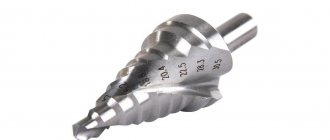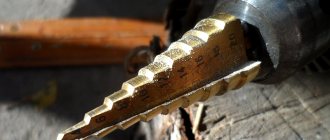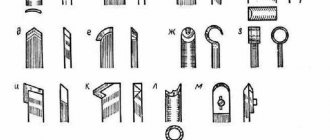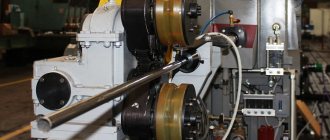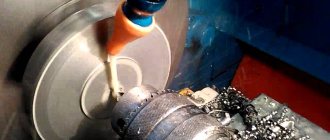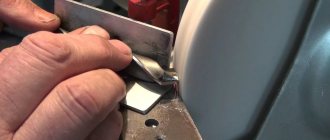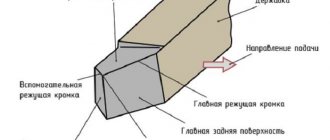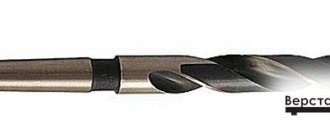Cylindrical Twist Drills
This is the most common type of this tool that can be found in the inventory of every master. Can be used in all types of drilling equipment and tools. They are made, according to GOST 885-77, from tool steel of such grades as HSS, P6M5 and P18, which ensures their reliability and durability.
However, in recent years, more and more often on store shelves you can find drills made of other, softer grades of steel; accordingly, the service life of such a tool is much lower. Read about how to choose the right drill and what to look for when choosing.
This type of drill has a diameter of 1-16 mm, but in some cases up to 80 mm (as a rule, they are made to special order for workshops and workshops) and is designed to perform almost all types of metal drilling work.
Diameters of metal drills of this type
The table shows the standard sizes of drills of this type for metalworking. It shows all the options for diameter, length and length of the working part.
| Diameter | 1 mm | 1.6 mm | 2.2 mm | 3 mm | 5 mm | 7 mm | 8 mm | 9 mm | 11 mm | 12 mm | 13 mm | 16 mm |
| Length | 56 mm | 76 mm | 95 mm | 100 mm | 132 mm | 148 mm | 156 mm | 165 mm | 175 mm | 195 mm | 205 mm | |
| Working length | 33 mm | 45 mm | 59 mm | 69 mm | 82 mm | 109 mm | 115 mm | 121 mm | 128 mm |
Other size options are rare; as a rule, they are produced in small quantities or to order from metalworking enterprises.
Conical drills for metal, their sizes and characteristics
This type of tool has a canonical shank, which is used in machine tools and some types of professional drilling tools and is designed for drilling large diameter holes. Therefore, it can extremely rarely be in the arsenal of a home master.
What diameter are conical drills? The diameter of this type of drill can be 6–30 mm and have increased or normal accuracy. For industrial machines, this tool can have a diameter of up to 75 mm. Below is a complete table with all sizes.
Classification
You can find different types of drills on sale. They are classified depending on color, material, type of shank, type of coating, and accuracy class.
By color
A faded yellow tint appears after a vacation at work. Thanks to additional processing, the durability and strength of the equipment increases.
The bright yellow equipment is durable and wear-resistant. It has a low friction index. The equipment has a titanium coating, which provides it with increased strength.
Black color indicates additional steam treatment. This is durable equipment with a long service life. The cost is not very high.
Drills of the lowest quality that have not been subjected to additional processing are gray in color. Such equipment has a low price, but you won’t be able to save money, since the drills break quickly.
By material
Drills are made from different types of steel:
- carbon tool;
- alloyed instrumental;
- high-speed
Additionally, plates made of hard alloys are attached to the cutting parts.
Steel drills (Photo: Instagram / linkorspb)
By shape
Kinds:
- Stepped, conical. They are also called gimlets. The working part has a conical shape. Designed for drilling holes of different diameters in metal sheets up to 2 mm thick.
- Centering. Multifunctional gimlets, which are needed for creating special holes in metal workpieces. The parts are fixed in drilling equipment.
- Elongated. Used to create blind, through holes.
- The first ones. Tool with replaceable inserts. With its help you can make large diameter holes with smooth walls.
- Crowned. Hollow crowns that have many sharp teeth along the edges. Suitable for drilling holes in thin metal sheets up to 30 mm in diameter.
- Threaded. Used for cutting threads in pre-prepared holes.
- Highly accurate. With their help, you can perform precise technological operations.
- Left-handed. Equipment for highly specialized purposes, which is needed for drilling damaged equipment out of holes.
The most common type of metal drills is twist drills. Designed for drilling holes of different depths and diameters.
Conical drills (Photo: Instagram / dismart_kh)
By shank type
Types of shanks:
- Conical. The equipment is designed for high-power, professional drills or industrial drilling machines.
- Cylindrical. Suitable for power tools.
- Hexagonal. Used for fastening in jaw chucks and clamps.
By type of coverage
The following can be applied to drills:
- titanium aluminum nitride;
- titanium carbonitride;
- diamond chips;
- titanium nitride ceramic coating;
- oxide film.
The last type of coating is the most affordable and reliable.
Cobalt drills (Photo: Instagram / vmiha80)
By accuracy class
Accuracy class:
- Normal accuracy marked B. Designed for drilling holes with an accuracy of up to 15 grade.
- Normal accuracy marked B Designed for drilling holes up to accuracy class 14.
- High precision equipment marked A1. Suitable for creating holes with accuracy from 10 to 13 classes.
Core drills for metal, diameters and characteristics
This type of tool is also called milling cutters because it looks completely different from a classic metal drill. Thanks to this equipment, it is possible to obtain large-sized holes - the diameter of which can be 12–150 mm, but a relatively small depth of 5–50 mm. This is due to the structure of the instrument itself.
The equipment is made of high-speed steel. Some drills are tipped with high-strength steel, which significantly speeds up the processing process, 4–12 times less than with conventional drills.
How to choose the right tool
When choosing the necessary tool, you need to know for what purpose you are purchasing it and take into account the characteristics of the metal with which you are going to work. There are several parameters that you should pay attention to:
- working diameter;
- quality of sharpening;
- surface color;
- symmetry of elements;
- metal characteristics;
- functionality;
- recommendations to manufacturers;
- manufacturer's reputation.
Marking drills for metal, decoding symbols
All metal drills, according to GOST requirements, must have markings that indicate the grade of steel from which the equipment is made.
If there is no such marking, most likely this drill meets the quality requirements and is not recommended for use in professional metalworking. However, for a home craftsman it can be an excellent option since it is cheaper.
Let's look at the markings that can be seen on the drill itself; it consists of letters and numbers, for example P 9, P18, P6m5, P9K15. Letter P
here means that this tool is made of high-speed steel. Next comes a number indicating the amount of tungsten in the steel. The following is the designation of the alloying substance in the alloy, example:
- K6 – the alloy contains six parts of cobalt.
- M4 – four parts of molybdenum are present.
- F3 – three parts of vanadium.
These elements increase strength, heat resistance and other characteristics.
Marking that comes with the accompanying documents (packaging) for the equipment. Equipment accuracy designation:
A1 – increased accuracy.
B1 – normal accuracy.
Example 2300-7055 A1 GOST 885-77, where 2300 is the operational and design characteristics, 7055 is the production serial number (series), A1 is the increased accuracy of the tool, GOST 885-77 is the tool meets the requirements of standards 886-77.
Dimensions
The dimensions of metal drills are indicated in government documents, which manufacturers of certified products must follow. The requirements are regulated by GOST 886–77, GOST 4010-77, GOST 10902–77. Depending on the size, accessories for power tools are divided into 3 groups:
- Short - self-tapping screws with a length from 20 to 131 mm. Outer diameter - up to 20 mm.
- Extended - equipment up to 205 mm long. The diameter is similar to short drills.
- Long - length up to 254 mm. Outer diameter - up to 20 mm.
Sometimes you need to make a hole for the self-tapping screw before screwing it in. There is no point in selecting equipment of the same diameter as the fastening element, since the fastening will not hold. To select the diameter, it is recommended to use ready-made calculation tables.
Drills of different lengths (Photo: Instagram / promoborydivanie)
Cone drills
The shape of the working part of such drills is a conical series of step-by-step annular transitions and a longitudinal-spiral or simply longitudinal groove, forming sharp cutting edges.
This makes it possible to use one tool to produce holes of different diameters. Thus, we save not only time on replacing drills during work, but also money on their assortment. Progressive changes in size are made with smooth transitions between steps. This surface shape promotes easy rotation and increased processing efficiency of sheet materials. The use of high-strength steels for the manufacture of cutting edges on step drills provides them with longer service life without sharpening.
An example of a cone drill
The tool allows you to perform technological operations at a time, which under normal conditions require the sequential use of several tools. The material can be processed at high speed, guaranteeing excellent edge quality, even with the smallest sheet thickness. This form of arrangement of cutting edges makes it possible to drill not only sheet steel, but also soft non-ferrous alloys, wood, plastics, gypsum and other products.
The sharp tip eliminates the need for pre-punching and ensures precise positioning of the tool during operation. Step drills can be installed on stationary machines, portable hand drills, and with adapters, even on a hammer drill and grinder.
Conclusion . Considering the design features and technical capabilities of drills, we can say that the main purpose of this tool is to drill holes in thin sheet workpieces. In addition, they are used to correct defects formed after the use of traditional drills in the form of burrs, misalignment, triangular holes and others. Therefore, such drills are widely used in car repair, plumbing installation, electrical panel manufacturing, construction and finishing work.
Which step drills for metal are better - manufacturer's choice
An important criterion when purchasing a stepped nozzle is the manufacturer, since only products from trusted companies will have the required characteristics.
The market offers both domestically produced and imported attachments. Among the best Russian samples are the Zubr, Interskol and Tulamash step drills. All of these companies offer high-quality products, either individually or in sets, with a subsequent guarantee.
Among the imported manufacturers, we can note the companies Bosch, Haisser, Ruko Precision Tools.
Manufacturers of step drills
Products made in China are of low quality (there are exceptions). To buy a good cone drill, you should pay attention to tools made in Europe and Russia.
1. “Zubr” - stepped drills from a domestic manufacturer are of reasonable cost. The quality is at a fairly high level.
Cone drills can be made from ordinary tool steel or coated with more wear-resistant alloys. In the latter case, the price will be significantly higher, but the quality of the cutting surface will remain sharp longer even when performing a large volume of work.
2. “Attack” - Russian-made conical drills, which in quality and cost are not inferior to the best products from foreign companies.
Reviews about the products of this company are only positive, so you don’t have to worry about the quality, and in order not to overpay, you should select a tool taking into account the maximum diameter that will be needed in the work.
3. “Bosch” - the products of this German company are excellent for professionals and for working with metal at home.
The diameters on the tool are marked using a laser system, so in case of long-term use, the inscriptions are not erased. To increase the drilling speed, the top of the Bosch step drill is sharpened crosswise, and the workpiece is ground in both the transverse and radial directions.
Such processing of the tool allows, when using it, to obtain a high-quality hole, the diameter of which will fully correspond to the stage of the product.
Video:
4. “Falon-Tech” - drills from a German company have an additional titanium coating, which allows you to increase the tool life by more than 2 times.
The product has a laser marked diameter and a standard shank that is ideal for use with a screwdriver or hand drill.
Despite the increased quality of the product, its cost remains low. If you need to purchase a cone drill for home use, then the choice of products from this company is the most optimal.
Video:
All of these cutting tools do an excellent job of drilling metal up to 4 mm thick. If you need to work with thicker metal, it is recommended to use core drills.
What is the difference between small diameter drills and conventional tools?
Small-class microdrills include tools for producing round holes with a diameter of 0.1 to 1 mm. A standard set of wood drills includes up to ten units with a range of 3 to 12 mm. Sets for fine work are equipped with sizes from 0.3 to 3.2 mm.
The main difference between small-diameter drilling tools and the usual size range is the design features, material used and operating conditions:
- Microdrills with a diameter of 0.5 mm - 1 mm are made of high-speed steel P6M5K5 or HSS-Co, according to the Western classification of alloy materials. Thinner ones, from 0.5 mm and less, are pressed and sintered from tungsten-cobalt or tungsten-molybdenum alloy;
- Shanks and holders for drilling tools of the smallest diameter are made with an increased diameter, usually up to 3 mm. Tools based on tungsten alloys are highly brittle, so it can be fixed in a collet clamp or in a special chuck only if the shank is enlarged to its normal size.
For your information! Drilling with microdrills is carried out using drills of a special design, the rotation speed of which is an order of magnitude higher than the standard 1200-2000 rpm for conventional screwdrivers. Therefore, the drilling of micro-holes in solid materials is carried out using several drills, with a consistent increase in diameter.
Drill design with a diameter of up to 1 mm
High rotation speeds of the cutting edge ensure good cutting quality of the material. Tungsten tools are sharpened with a cutting edge angle of up to 120°, which allows you to drill even alloy steels. As a rule, the manufacturer of high-quality micro drills has special markings on the box indicating what types of metal the tool is intended for.
The standard design of a thin carbide microdrill is shown in the photo. The length of the carbide spiral cutting part for all drills in the set, as a rule, does not exceed 15 mm, with a shank length of up to 20 mm and a diameter of 3 mm. The hole is drilled to a maximum depth of 4-5 mm.
Chinese micro drill sets can have a hex shank with a seat size of 2.5 mm and a length of 15 mm.
By using a standard diameter shank set for all carbide drills, you can secure a carbide drill of any size using a regular collet with a centering sleeve with a 3mm hole. In addition to collet devices, lightweight chucks for an engraving machine or Dremel are also used.
Microdrills made from high-speed steel P6M5K5 or HSS-Co are manufactured according to a standard design with a cylindrical shank and a double-fluted cutting surface.
This approach greatly simplifies mounting in a drill chuck, but complicates the work if it is necessary to drill several holes of different diameters at the same time. For drilling tools with a diameter greater than 2 mm, material and size information is engraved on the shank.
For your information! Information about the diameter of the microdrill is applied by the manufacturer to the cells of the kit in which the tool is laid out, or is provided in the form of a diagram on the back of the box.
Therefore, if the drills from the set, for some reason, were removed or scattered, they can only be collected and placed into the cells of the box after checking with a micrometer.
Typical drill sets for various materials
Initially, when developing the design and materials, leading manufacturers adopted an approach in which a set of drilling tools of different diameters was oriented towards use for drilling a specific material. Therefore, all microdrills in the set differ only in diameter. The sharpening angle of the edge, the inclination of the spiral grooves for chip removal and the cutting speed are exactly the same for all elements of the set.
Sets of microdrills for drilling steel and alloys are distinguished by the tool material used:
- Drills made of HSS-E steel, alloyed with cobalt up to 5%, for processing alloyed, carbon, hardened high-strength steels;
- Sets of microdrills made of HSS-G steel for processing lighter materials - graphite, copper, aluminum, all types of cast iron. The drill is subjected to particularly precise multi-pass grinding, so the resulting hole has an accuracy class of A, with a tolerance of h8;
- Ordinary microdrills made from high-speed steel HSS-R are produced both in single versions and in the form of a set, with a range of diameters from 0.1 to 3 mm. This tool can be used for drilling wood, soft polymers and composites.
Micro drills cannot be classified as ordinary metal-cutting tools; most often, sets of small diameter drills, up to 1 mm, are used by engravers and repairmen. Such a kit is not cheap, so the best option would be to buy a high-quality tool from a well-known brand, for example, Bosch or Heller.
High quality German drills
is rightfully considered the world's first manufacturer of drilling tools, both for domestic purposes and in industrial production. The quality of Heller set drills is determined by the very precisely selected characteristics of the cutting edge and the HSS high-speed steel used.
The standard form of sale of the kit is a case, a metal box with a folding tripod in which the drills are located. For household purposes, the tool can be sold in plastic packaging with mandatory marking of the material and a number of drill diameters included.
For professional activities, the Heller HSS Cobalt and Heller Prefix HSS-Super kits are used. In addition to a large selection of tool diameters, the drills presented in the Perfix set are made using triple center grinding technology.
Russian drilling tools
Among the numerous products of machine-building plants that produce metal-cutting tools, both of their own design and of licensed type, we can note the products of young and dynamically developing ones. You can evaluate the quality of manufactured drills for a wide range of applications using a set for drilling steels and alloys, with a tensile strength of up to 800 MPa.
The set is called “Technician” and contains 370 units of tools, assembled in 19 sections of a metal case. The drills are made of steel R4M2 in accordance with the requirements of GOST 10902-77 for accuracy class B1. This set of drills for metal “Bison” costs 49 thousand rubles for one set. According to the manufacturer, the set is designed for use in repair shops, service stations and small mechanical assembly areas.
In addition to general-purpose tools, it offers the 429625H20P set under the trade names “Expert” and “Met-Sh”. It includes ten and twenty drills, respectively, with a diameter of 0.33 mm to 1 mm. The tool is made from inexpensive high-speed steel R6M5. According to the manufacturers, the microdrills included in the set provide high positioning accuracy due to the presence of a cross-shaped reverse sharpening of the cutting edge.
The cost of the kit does not exceed 500 rubles; it is designed for use in repairing printed circuit boards of small household appliances.
Drill set made in China
Most often, to repair household appliances, small appliances and tools, you buy a simple and relatively inexpensive drilling kit made in China from an unknown company, as in the photo.
A set of 150 units of drills of various diameters, from 0.4 mm to 3.2 mm, is placed in a gray plastic case. The top cover is made of transparent plastic, with size and diameter markings on the surface. There are no markings on the tool itself, so if the lid is slightly opened, or the box is shaken vigorously, most of the drills will fly out of their cells, and it will be very difficult to sort them by size.
The drills are made and sharpened according to the old Soviet pattern with a centering belt on the edge. The quality of sharpening can be seen from the photo. The tool life will be a maximum of 4-5 drills. The cost of the set is 560 rubles.

